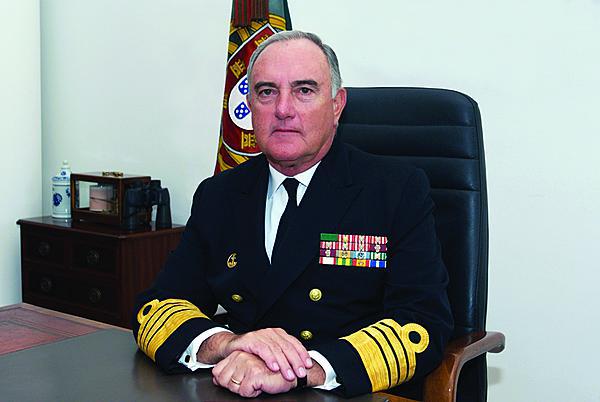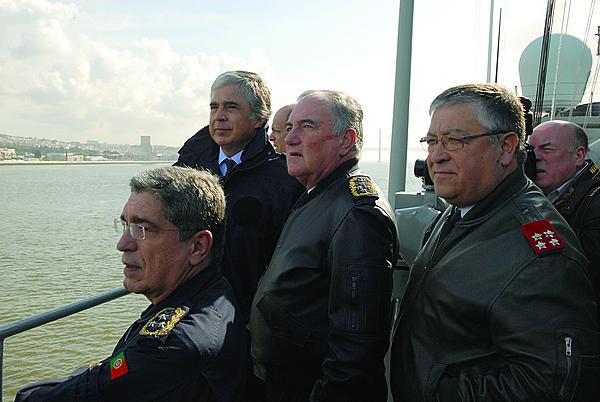Portugal's Navy Faces Double-Edged Challenge
The economic and technological challenges facing Western militaries are magnified for Portugal as it tries to ensure the viability of its navy. The small maritime nation that regularly participates in NATO naval operations is facing severe budgetary constraints as its domestic economy contracts, but it must improve and even increase its capabilities as a result of a growing mission set.
The first challenge facing the Portuguese navy is to meet its obligations amid the severe fiscal crisis gripping most of the Western world. Portugal has been hit hard by austerity measures amid high unemployment, and the navy’s budget may not grow significantly for the foreseeable future. The Portuguese Defense Ministry has stated the defense budget will remain at about 1.1 percent of the country’s gross domestic product (GDP) through 2020, but that GDP has been contracting since late 2010.
The second major challenge for the navy is to address the country’s new geopolitical makeup at sea. Portugal has applied for exclusive economic zone continental shelf status beyond the traditional 200 miles to encompass the Azores and Madeira, which are Portuguese territory. This would link and extend the three separate economic zones into a larger single zone. The result would be a much larger maritime area of about 3.8 million square kilometers (2.4 million square miles) that would need protection by the Portuguese navy, especially with regard to ocean-based resources ranging from fishing stocks to potential oil deposits.
Adm. José Saldanha Lopes, PON, is the chief of the Portuguese Naval Staff. He is pursuing a plan for his successors that would ensure the viability of the navy through the year 2035. Technology, fleet transformation and a shift in funding priorities are at the heart of the thrust for an effective future navy without significant funding increases.
“I believe that we still have the capability of having the right budget to accomplish the missions that we must accomplish,” he declares.
The admiral is addressing the two interlocking challenges on several fronts. First, he wants to increase the presence of technology and add new systems that will improve the effectiveness of the navy, particularly for maritime situational awareness. More sophisticated systems also will allow the navy to downsize its personnel numbers, the admiral notes.
The navy already has replaced its submarine fleet with two submarines that are much more sophisticated than their predecessors, the admiral offers. They have far greater capability than the three vessels they replaced, he emphasizes, and each new boat has half the number of crew members that each of the older submarines required.
The navy also is looking to replace its old corvettes with new 2,000-ton ocean patrol vessels, which also will have half the personnel of the older craft. The first vessel became operational about a year ago, and the second is finishing its sea trials. The admiral allows that this effort is stumbling somewhat, but he looks to the country’s shipyards to bring about its success.
New technologies will enable operations with fewer people, and downsizing personnel numbers will allow the navy to shift funds to operation and maintenance. With a core force of five frigates joining the two submarines and the patrol vessels, the navy’s main objective is to maintain the vessels’ combat capability. “My main priority is to not lose the timing for mid-life upgrades, particularly for combat systems,” the admiral emphasizes.
As Portugal faces the possibility of suddenly having a large oceangoing patrol area, its navy is emphasizing maritime situational awareness. Adm. Saldanha Lopes stresses the importance of being able to obtain information from different sources, some of which will be from foreign countries. That information must be correlated and consolidated for analysis and dissemination to the appropriate users.
This will be necessary for the variety of missions Portugal must assume with its increased maritime responsibilities. “We are talking about several assets that can be employed—it is ships and aircraft,” he says. Even just search and rescue responsibilities involve close work with the Portuguese air force, the admiral notes.
Other vital maritime information comes from satellites, particularly European Union orbiters, the admiral continues. One of the most important maritime threats that lends itself to satellite detection is pollution, he notes, adding that its detection and tracking—including identifying and pursuing the source—is a major concern. Portugal also is looking to develop its own stable of unmanned aerial vehicles.
All this data must be consolidated to generate effective knowledge. And, it must be disseminated in the right form to the proper users, whether within the navy or in other agencies or military services.
Improved automation will help generate better planning, the admiral says. This will improve efficiencies and save money. Accordingly, one of the keys to modernizing the Portuguese navy is business intelligence.
This is an umbrella term that encompasses applications, infrastructure and tools for developing the best practices to access and analyze information accurately. The overarching goal is to transform data into more useful knowledge. Adm. Saldanha Lopes notes that effective decision making relies heavily on the quality of information, and business intelligence is vital for addressing those needs before they reach the decision maker.
The business intelligence approach the navy is taking involves selecting key indicators to be measured and analyzed. This in turn generates the required knowledge to improve the decision-making process. The approach is being followed at the strategic, operational and tactical levels for activities such as transformation management, maritime situational knowledge development and force readiness and performance improvement.
“We are trying to have better tools for having more accurate analysis, and that of course will generate the knowledge needed to make better decisions,” the admiral states. “This is an ongoing process; because we are not just focusing on a particular point, [but instead] we are trying to assemble all the information together.
“With the amount of information that we have, we cannot use just a pencil and paper,” he continues. “Nowadays, we need to have powerful tools based on computers for a faster way to have all the analyses that provide us with the means to decide quickly.”
In terms of communications and information systems (CIS), the admiral allows that the navy has chosen a different course in CIS development from that of the other Portuguese military services. The army and the air force had different requirements that reflected their respective environments. Portugal is working toward building a strong CIS structure using domestic as well as foreign companies. The country will invest in software that would help process the overwhelming amount of data that is flooding CIS systems.
This structure would focus on a national strategic approach and would be accessible to the other services. The navy would be able to contact air assets, for example, with seamless interoperability. The admiral continues that Portugal is following the same pattern employed by wealthier NATO nations.
Portugal’s navy has participated in many NATO operations, most recently including counterpiracy activities off the Horn of Africa. In the past, the navy would incorporate capabilities serving national strategic objectives. The admiral notes that NATO tried to compel Portugal to invest in specific capabilities that would be complementary to those other NATO forces, but Portugal declined where those capabilities did not meet its own national needs.
“I am happy that we took this course,” Adm. Saldanha Lopes declares, adding that the Portuguese navy now can use most of its capabilities both to serve its own strategic purposes as well as to fulfill international obligations. “This is the right way.”
Being able to pool and share military capabilities with other countries also in financial difficulty benefits all participants. Success in that endeavor depends on the mission, he notes, adding that the navy participated in several shared operations during the past year. In some cases, the navy has engaged in cooperative activities with the same nations in different operations. The same navies shifted from one operation to another together, adding other navies as needed.
For example, the Portuguese navy has 10 ships engaged in counterpiracy activities. Ships leaving that operation can redeploy to the Mediterranean Sea for operations such as NATO’s Active Endeavor. “It is the kind of cooperation of assets that can be helpful for the different fronts that we have in NATO,” the admiral observes.
Adm. Saldanha Lopes expresses concern about NATO’s reaction time to potential threats. For example, a new piracy threat is emerging in the Gulf of Guinea off the west coast of Africa. “I am not sure that NATO is responding as quickly as it should,” he allows. Some countries already have sent ships to the gulf, he notes, but these pirates are behaving very differently from their counterparts off the coast of Somalia. “I am not sure if the quick response that we would need, to show the strength of NATO, is there to use the assets so that countries can cooperate with each other.”






Comments